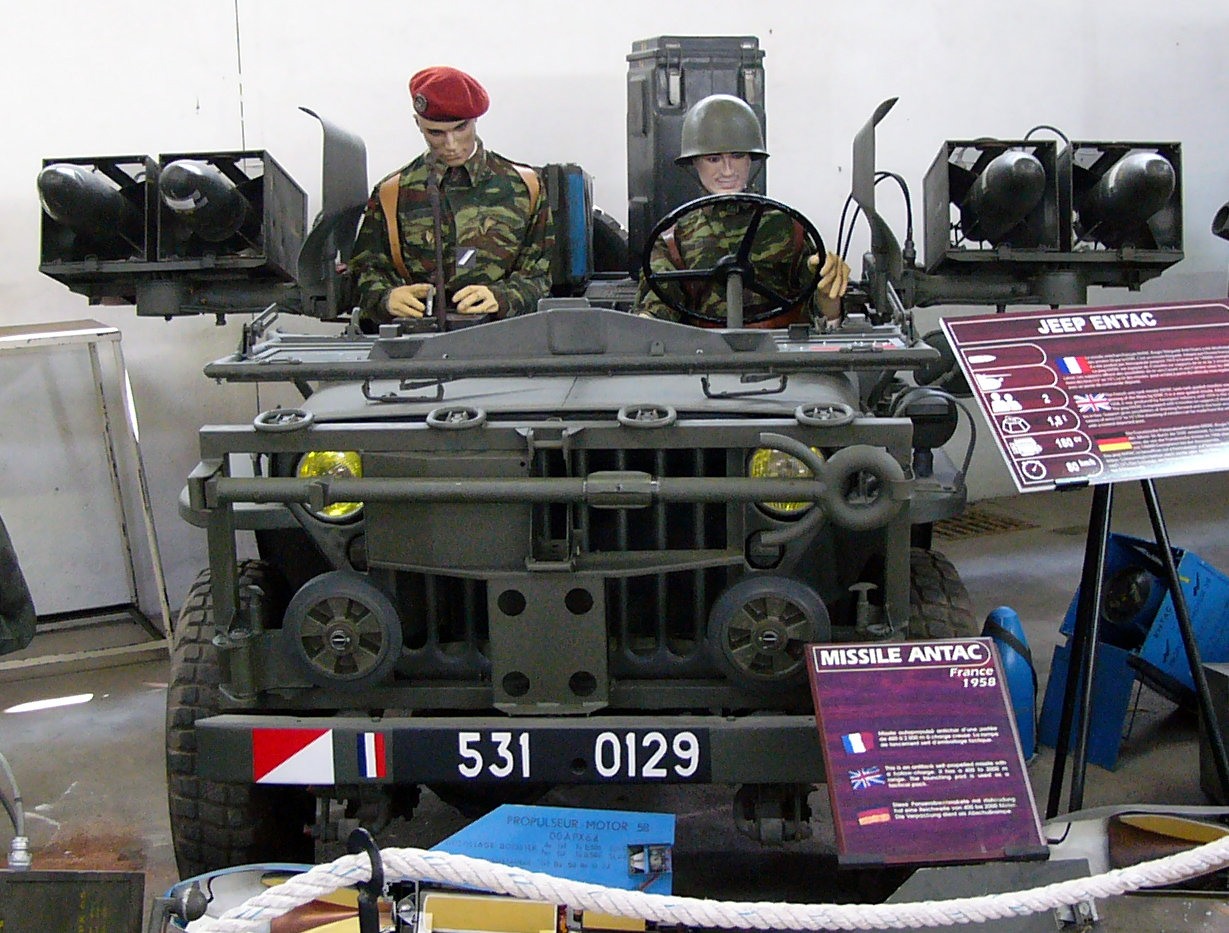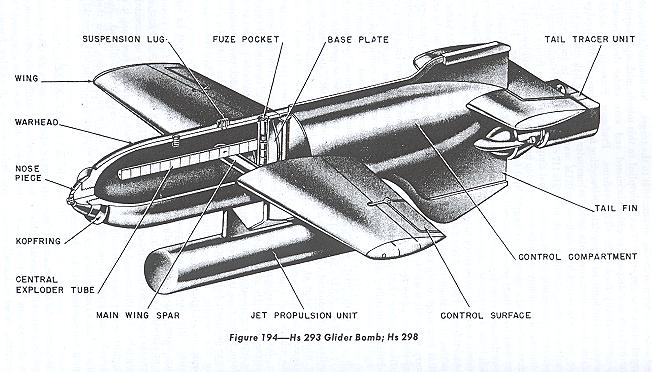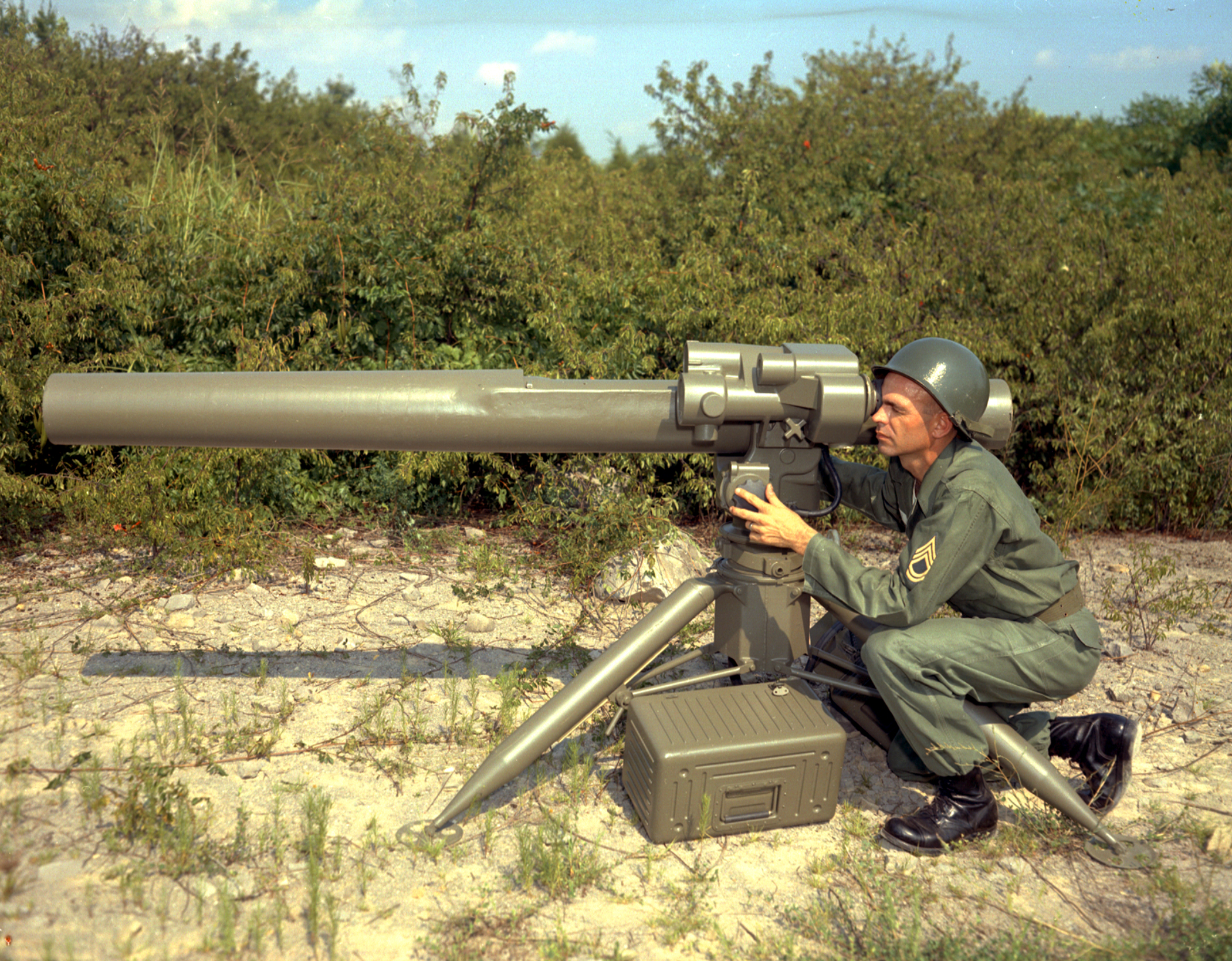|
MCLOS
Manual command to line of sight (MCLOS or MACLOS) is a method for guiding guided missiles. With an MCLOS missile, the operator must track the missile and the target simultaneously and guide the missile to the target. Typically the missile is steered with a joystick, and its path is observed through a periscope-type telescopic sight. The missiles are usually equipped with a magnesium flare in the base that automatically ignites on launch and allows the gunner to visually track the fast-moving missile in a manner similar in concept to tracer ammunition. MCLOS requires considerable training and practice to master, since even a minor disruption in the gunner's concentration would likely cause a miss. These guidance systems have marginal accuracy on tank-sized targets, even with perfect line-of-sight by the gunner, due to erratic flight paths requiring timely manual corrections. As demonstrated by the Israeli Army under fire from Soviet-armed Arab states, responding to the distinc ... [...More Info...] [...Related Items...] OR: [Wikipedia] [Google] [Baidu] |
AT-3 Sagger
The 9M14 Malyutka (; "Little one", NATO reporting name: AT-3 Sagger) is a manual command to line of sight (MCLOS) wire-guided anti-tank guided missile (ATGM) system developed in the Soviet Union. It was the first man-portable anti-tank guided missile of the Soviet Union and is probably the most widely produced ATGM of all time—with Soviet production peaking at 25,000 missiles a year during the 1960s and 1970s. In addition, copies of the missile have been manufactured under various names by at least six countries. Although they have been supplanted by more advanced anti-tank guided missiles, the Malyutka and its variants have seen widespread use in nearly every regional conflict since the 1960s and are still kept in large stockpiles and sometimes used to this day by non state actors such as Hezbollah. Development Development began in July 1961 with the government assigning the project to two design teams: Tula and Kolomna. The requirements were: * Vehicle mountable and/or man p ... [...More Info...] [...Related Items...] OR: [Wikipedia] [Google] [Baidu] |
AGM-12 Bullpup
The AGM-12 Bullpup is a short-range air-to-ground missile developed by Martin Marietta for the US Navy. It is among the earliest precision guided air-to-ground weapons and the first to be mass produced. It first saw operational use in 1959 on the A-4 Skyhawk, but soon found use on the A-6 Intruder, F-100 Super Sabre, F-105 Thunderchief, F-4 Phantom II, F-8 Crusader, and P-3 Orion in both Navy and US Air Force service, as well as NATO allies. The weapon was guided manually via a small joystick in the aircraft cockpit, which presented a number of problems and its ultimate accuracy was on the order of , greater than desired. In the 1960s it was increasingly supplanted by fully automatic weapons like the AGM-62 Walleye and AGM-65 Maverick. History ASM-N-7 Bullpup Development of Bullpup began in 1953 when Korean War experience demonstrated the almost complete inability for conventional bombing to attack point land targets like bridges. There had been great experimentation during Wor ... [...More Info...] [...Related Items...] OR: [Wikipedia] [Google] [Baidu] |
3M6 Shmel
The 3M6 (; ) is an MCLOS wire-guided anti-tank missile of the Soviet Union. Its GRAU designation is "3M6" and its NATO reporting name is AT-1 Snapper. Too large to be manportable, it was typically deployed from specialised vehicles or helicopters. The missile was intended to supplement traditional anti-tank weapons, like the 100 mm anti-tank gun whose accuracy beyond 1,500 m is poor. The missile's accuracy in contrast remained high as far as its maximum range of 2,000 m. However, the system's bulk, slow speed and poor combat accuracy drove development of later SACLOS systems, like the 9M113 Konkurs. Development The 3M6 began development through Decree No. 7 on May 27, 1957. Development would be spread across several bureaus and research institutes, with the missile complex and rocket being designed by SKB-4, led by Boris Shavyrin under the leadership of the to-be famous Sergey Nepobedimy, being based on the Nord Aviation SS.10. Teams from , led by Zinovy Moiseevich Persi ... [...More Info...] [...Related Items...] OR: [Wikipedia] [Google] [Baidu] |
ENTAC
ENTAC ("Engin Téléguidé Anti-Char") or MGM-32A was a French MCLOS Wire-guided missile, wire-guided anti-tank missile. Developed in the early 1950s, the weapon entered service with the French Army in 1957. Production ended in 1974 after approximately 140,000 had been built. Development The missile was developed by the French Government agency - DTAT (''Direction Technique des Armements Terrestres'') at the same time as the private industry SS.10. Development time for the ENTAC was longer than the SS.10, so it did not enter service until 1957. It proved to be a great improvement over the SS.10, which had entered production five years earlier. Once fully developed and tested, production of the ENTAC was given to the firm of Aerospatiale. The ENTAC was designed to be a man-portable weapon or operated from a small vehicle like the Jeep, replacing the Nord SS.10 in French service. Design The missile is launched from a simple metal box, which is connected to an operator station. A ... [...More Info...] [...Related Items...] OR: [Wikipedia] [Google] [Baidu] |
Henschel Hs 293
The Henschel Hs 293 was a World War II Nazi Germany, German Command guidance, radio-guided glide bomb. It is the first operational anti-shipping missile, first used unsuccessfully on 25 August 1943 and then with increasing success over the next year, damaging or sinking at least 25 ships. Allied efforts to jam the radio control link were increasingly successful despite German efforts to counter them. The weapon remained in use through 1944 when it was also used as an air-to-ground weapon to attack bridges to prevent the Allied breakout after D-Day, but proved almost useless in this role. Development The Hs 293 project started in 1940, based on the "Gustav Schwartz Propellerwerke" pure glide bomb designed in 1939. The Schwartz design did not have a terminal guidance system; instead, it used an autopilot to maintain a straight course. It was intended to be launched from a bomber at sufficient distance to keep the aircraft out of range of anti-aircraft artillery, anti-aircraft ... [...More Info...] [...Related Items...] OR: [Wikipedia] [Google] [Baidu] |
Fritz X
Fritz X was a German guided anti-ship glide bomb used during World War II. Developed alongside the Henschel Hs 293, ''Fritz X'' was one of the first precision guided weapons deployed in combat. ''Fritz X'' was a nickname used both by Allied and ''Luftwaffe'' personnel. Alternative names include Ruhrstahl SD 1400 X, Kramer X-1, PC 1400X or FX 1400 (the latter, along with the unguided PC 1400 ''Fritz'' nickname, is the origin for the name "Fritz X"). History ''Fritz X'' was a further development of the PC 1400 (''Panzersprengbombe, Cylindrisch'' 1,400 kg):de:Deutsche Abwurfmunition des Zweiten Weltkrieges#Panzersprengbombe (PC und PD), German Wikipedia's WW II PC-series bomb specifications, German for "armour-piercing bomb, cylindrical". armour-piercing high-explosive bomb, itself bearing the nickname ''Fritz''. It was a penetration weapon intended to be used against armoured targets such as heavy cruisers and battleships. It was given a more aerodynamic nose, four stub ... [...More Info...] [...Related Items...] OR: [Wikipedia] [Google] [Baidu] |
AT-1 Snapper
The 3M6 (; ) is an MCLOS wire-guided anti-tank missile of the Soviet Union. Its GRAU designation is "3M6" and its NATO reporting name is AT-1 Snapper. Too large to be manportable, it was typically deployed from specialised vehicles or helicopters. The missile was intended to supplement traditional anti-tank weapons, like the 100 mm anti-tank gun whose accuracy beyond 1,500 m is poor. The missile's accuracy in contrast remained high as far as its maximum range of 2,000 m. However, the system's bulk, slow speed and poor combat accuracy drove development of later SACLOS systems, like the 9M113 Konkurs. Development The 3M6 began development through Decree No. 7 on May 27, 1957. Development would be spread across several bureaus and research institutes, with the missile complex and rocket being designed by SKB-4, led by Boris Shavyrin under the leadership of the to-be famous Sergey Nepobedimy, being based on the Nord Aviation SS.10. Teams from , led by Zinovy Moiseevich Persi ... [...More Info...] [...Related Items...] OR: [Wikipedia] [Google] [Baidu] |
Blowpipe Missile
The Shorts Blowpipe is a man-portable (MANPADS) surface-to-air missile that was in use with the British Army and Royal Marines from 1975 to 1985. It also saw service in other military forces around the world. Most examples were retired by the mid-1990s. It is unique among MANPADS in that it is manually guided to its target with a small joystick, sending guidance corrections to the missile over a radio control link. Blowpipe underwent a protracted and controversial development between the programme's initial conception in 1966 and 1975 when it finally entered service. It had its first use during active combat in the Falklands War in 1982 when it was used by both sides of the conflict. Its demonstrated performance was poor, with only two confirmed kills. As a result of the poor performance of the system, an improved version offering semi-automatic guidance was introduced as Javelin. This was further improved with a laser designator system in Javelin S15, which was later renamed ... [...More Info...] [...Related Items...] OR: [Wikipedia] [Google] [Baidu] |
Ruhrstahl X-4
The Ruhrstahl Ru 344 X-4 or Ruhrstahl-Kramer RK 344 was a Wire-guided missile, wire-guided air-to-air missile designed by Germany during World War II. The X-4 did not see operational service and thus was not proven in combat but inspired considerable post-war work around the world, and was the basis for the development of several ground-launched anti-tank missiles. History During 1943, the Royal Air Force, RAF's RAF Bomber Command, Bomber Command and the US Air Force mounted a series of heavy raids against Germany. Despite heavy bomber losses, these prompted ''Luftwaffe'' research into considerably more powerful anti-bomber weaponry in order to reduce the cost in lost fighter aircraft and aircrew. A massive development effort resulted in a number of heavy-calibre autocannon designs, air-to-air rockets, Surface-to-air missile, SAMs, and the X-4. Work on the X-4 began in June 1943, by Dr Max Kramer at . The idea was to build a missile with enough range to allow it to be fired f ... [...More Info...] [...Related Items...] OR: [Wikipedia] [Google] [Baidu] |
Azon
AZON (or Azon), from "azimuth only", was one of the world's first guided weapons, deployed by the Allies and contemporary with the German Fritz X. Officially designated VB-1 ("Vertical Bomb 1"), it was invented by Major Henry J. Rand and Thomas J. O'Donnell during the latter stages of World War II as the answer to the difficult problem of destroying the narrow wooden bridges that supported much of the Burma Railway. AZON was essentially a general-purpose AN-M65 bomb with a quadrilateral 4-fin style radio controlled tail fin design as part of a "tail package" to give the desired guidance capability, allowing adjustment of the vertical trajectory in the yaw axis, giving the Azon unit a lateral steering capability (meaning it could only steer left and right, and could not alter its pitch or rate of fall). This lack of any pitch control meant that the bombardier still had to accurately release it with a bombsight to ensure it could not fall short of or beyond the target. The ... [...More Info...] [...Related Items...] OR: [Wikipedia] [Google] [Baidu] |
Swingfire
Swingfire was a British wire-guided anti-tank missile developed in the 1960s and produced from 1966 until 1993. The name refers to its ability to make a rapid turn of up to ninety degrees after firing to bring it onto the line of the sighting mechanism. This means that the launcher vehicle could be concealed and the operator, using a portable sight, placed at a distance in a more advantageous firing position. Swingfire entered operational service in 1969 and underwent several major upgrades during its time in service. It was used on a number of vehicles including the FV438, FV102 and several truck mountings including the Land Rover and Ferret armoured car. Concepts adapting it to helicopters, tanks and even hovercraft went nowhere. Swingfire remained in service on the FV102 Striker until 2005 when they were retired in favour of man-portable missiles. Development Earlier efforts The British Army was among the first to introduce a heavy anti-tank missile when they introduce ... [...More Info...] [...Related Items...] OR: [Wikipedia] [Google] [Baidu] |
BGM-71 TOW
The BGM-71 TOW ("Tube-launched, Optically tracked, wire-guided missile, Wire-guided", pronounced ) is an American anti-tank missile. TOW replaced much smaller missiles like the SS.10 and ENTAC, offering roughly twice the effective range, a more powerful warhead, and a greatly improved semi-automatic command to line of sight (SACLOS) that could also be equipped with infrared cameras for night time use. First produced in 1968, TOW is one of the most widely used anti-tank Missile guidance, guided missiles. It can be found in a wide variety of manually carried and vehicle-mounted forms, as well as widespread use on helicopters. Originally designed by Hughes Aircraft in the 1960s, the weapon is currently produced by RTX Corporation, RTX. History Previous designs Late in World War II, the German Army began experimenting with modified versions of the Ruhrstahl X-4 wire-guided missile. Originally developed for the ''Luftwaffe'' as an anti-bomber weapon, by changing the warhead to one u ... [...More Info...] [...Related Items...] OR: [Wikipedia] [Google] [Baidu] |









